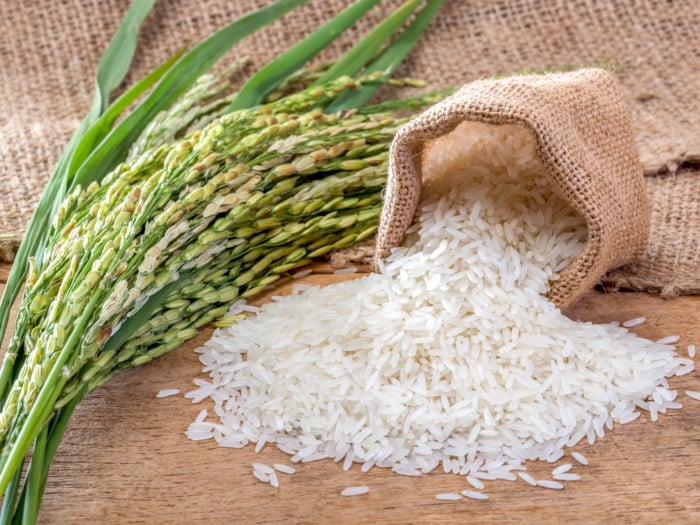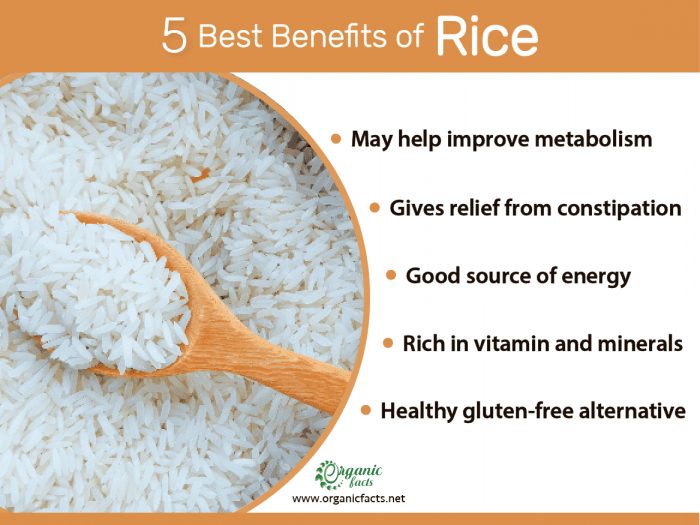Rice is known to be a good source of various vitamins like niacin, thiamin, and riboflavin, and offering various health benefits. Brown rice is also rich in fiber and manganese, thereby improving digestion and overall health.
It also has the ability to provide instant energy, regulate and improve bowel movements, and manage blood sugar levels. It also plays a role in providing vitamin B1 to the human body.
Table of Contents
- What is Rice? [1]
- Rice Nutrition [2]
- Health Benefits
- May Prevent Obesity
- Potentially Gluten-free
- May Control Hypertension
- May Improve Skin Care
- May Have Diuretic & Digestive Qualities
- May Improve Metabolism
- May Boost Cardiovascular Health
- May Relieve IBS
- May Relieve Constipation
- May Provide Energy
- May Controls Diabetes
- Selection [15]
- How to Add Rice to your Diet? [16]
What is Rice?
Rice is a cereal grain, which belongs to the grass species Oryza sativa and Oryza glaberrima, also known as Asian and Australian rice respectively. The grain comes in more than 40,000 varieties with different shapes, sizes, textures, aroma, and colors.
Different types include white, brown, rose, noodle, black pearl, red yeast, wild, jasmine, and sushi rice, among others. They can be long-grain, medium-grain, and short-grain and take a very short preparation time.
It is also known for the number of benefits that it imparts, becoming the reason it is often used in pet food, as an ingredient in cosmetics such as facial cleansers and moisturizers, and dietary supplements and pills.
Rice Nutrition
Most varieties of rice contain a high amount of carbohydrates and protein. The fiber content varies according to its different types. For eg., brown rice has more fiber than white and therefore, is often constituted as a healthy option. According to the USDA National Nutrient Database, it is also rich in minerals like calcium, iron, sodium, potassium, manganese, selenium, and copper. The vitamins in it include niacin, pantothenic acid, and thiamin. It is a great food for people wanting a gluten-free option and it contains negligible fat. [17]
For most people, it is synonymous with short-grained white rice. This variety is considered healthy as it contains most of the nutrients.
| Serving Size : | |
|---|---|
| Nutrient | Value |
| Water [g] | 68.44 |
| Energy | 130 |
| Energy [kJ] | 544 |
| Protein [g] | 2.69 |
| Total lipid (fat) [g] | 0.28 |
| Ash [g] | 0.41 |
| Carbohydrate, by difference [g] | 28.17 |
| Fiber, total dietary [g] | 0.4 |
| Sugars, total including NLEA [g] | 0.05 |
| Calcium, Ca [mg] | 10 |
| Iron, Fe [mg] | 1.2 |
| Magnesium, Mg [mg] | 12 |
| Phosphorus, P [mg] | 43 |
| Potassium, K [mg] | 35 |
| Sodium, Na [mg] | 1 |
| Zinc, Zn [mg] | 0.49 |
| Copper, Cu [mg] | 0.07 |
| Manganese, Mn [mg] | 0.47 |
| Selenium, Se [µg] | 7.5 |
| Fluoride, F [µg] | 41.1 |
| Thiamin [mg] | 0.16 |
| Riboflavin [mg] | 0.01 |
| Niacin [mg] | 1.48 |
| Pantothenic acid [mg] | 0.39 |
| Vitamin B-6 [mg] | 0.09 |
| Folate, total [µg] | 58 |
| Folic acid [µg] | 55 |
| Folate, food [µg] | 3 |
| Folate, DFE [µg] | 97 |
| Choline, total [mg] | 2.1 |
| Betaine [mg] | 0.3 |
| Vitamin E (alpha-tocopherol) [mg] | 0.04 |
| Fatty acids, total saturated [g] | 0.08 |
| 14:0 [g] | 0 |
| 16:0 [g] | 0.07 |
| 18:0 [g] | 0.01 |
| Fatty acids, total monounsaturated [g] | 0.09 |
| 16:1 [g] | 0 |
| 18:1 [g] | 0.09 |
| Fatty acids, total polyunsaturated [g] | 0.08 |
| 18:2 [g] | 0.06 |
| 18:3 [g] | 0.01 |
| Tryptophan [g] | 0.03 |
| Threonine [g] | 0.1 |
| Isoleucine [g] | 0.12 |
| Leucine [g] | 0.22 |
| Lysine [g] | 0.1 |
| Methionine [g] | 0.06 |
| Cystine [g] | 0.06 |
| Phenylalanine [g] | 0.14 |
| Tyrosine [g] | 0.09 |
| Valine [g] | 0.16 |
| Arginine [g] | 0.22 |
| Histidine [g] | 0.06 |
| Alanine [g] | 0.16 |
| Aspartic acid [g] | 0.25 |
| Glutamic acid [g] | 0.52 |
| Glycine [g] | 0.12 |
| Proline [g] | 0.13 |
| Serine [g] | 0.14 |
| Sources include : USDA [18] | |
Health Benefits
It is a fundamental food in many cuisines around the world and is an important cereal crop that feeds more than half of the world’s population. The health benefits of this widespread crop are explained below.
May Prevent Obesity
Rice forms an integral part of a balanced diet as it can provide nutrients without having any negative impacts on health. Potentially low levels of fat, cholesterol, and sodium also help reduce obesity and associated conditions. While most people have this misconception that white rice consumption causes an increase in blood glucose levels, which is one of the reasons for obesity, a 2013 research paper showed that there was, in fact, no association between the frequency of consumption and body weight, BMI or central obesity. Most people prefer brown rice over white for it has more fiber content and is, therefore, more nutritious. [19] [20] [21] [22]
Potentially Gluten-free
Rice naturally does not contain any gluten and hence, causes no inflammation in the gut. However, it is important to ensure that there hasn’t been any contamination while procuring, manufacturing, or packaging. [23]
May Control Hypertension
According to research published in the Journal of Traditional and Complementary Medicine, rice enriched with gamma-aminobutyric acid or GABA helps in reducing hypertension. It also prevents the early onset of high blood pressure-related heart conditions. [24]

Rice is the most commonly used grain around the world. Photo Credit: Shutterstock
May Improve Skin Care
As per a study published in the journal Pharmaceutical Biology, rice bran has bioactive compounds that help prevent aging. They are also used in various skincare products. It is also shown to have possibly antioxidant and skin-hydrating potential. [25] [26]
Medical experts say that powdered rice can be applied topically to cure skin conditions. On the Indian subcontinent, its water is readily prescribed by Ayurvedic practitioners as an effective ointment to cool off inflamed skin surfaces.
May Have Diuretic & Digestive Qualities
As a diuretic, rice helps you eliminate toxins from the body like uric acid. It is also a possibly rich source of fiber, which increases bowel movement regularity and reduces the chances of cardiovascular diseases. [27]
May Improve Metabolism
According to a report published in the Journal of Functional Foods, black rice can help reduce obesity and improve metabolism among mice who were fed the same for a period of 12 weeks. However, more research on this is still required. [28]
May Boost Cardiovascular Health
As per a research published in the British Medical Journal, whole grains like rice help in reducing the risk of coronary heart diseases and other cardiovascular diseases. [29]
It is known to have antioxidant properties that can promote cardiovascular strength by reducing cholesterol levels in the body, according to a report published in the American Journal of Clinical Nutrition. Wild and brown varieties are far better than the white variety since the husk of the grain is where much of the nutrients are; ironically, the husk is removed in white rice preparation. [30] [31] [32]
May Relieve IBS
A team of researchers from New York University penned a detailed report on the recommended diet for Irritable Bowel Syndrome (IBS) in 2018 in the World Journal of Gastroenterology. In that, they concluded that a diet low in fermentable carbs known as FODMAPS is recommended for the management of this digestive disorder. Rice is a low FODMAP item, which is clinically suggested for consumption during IBS as it has resistant starch, which can reach the bowels and stimulates the growth of useful bacteria that help with normal bowel movements. [33] [34]
May Relieve Constipation
Rice can prevent chronic constipation. The insoluble fiber in it can act like a soft sponge that may be pushed through the intestinal tract quickly and easily. Brown rice and whole grains are known to be rich in insoluble fiber. However, it is also advisable to drink lots of water for relieving your constipated condition, in addition to eating fibrous foods. [35]

Rice comes in more than 40,000 varieties with different shapes, sizes, texture, aroma, and colors.
May Provide Energy
As per a study published in the journal ARYA Atherosclerosis, rice is a good source of carbohydrates, helps boost overall energy in the body. Carbohydrates are metabolized by the body and turned into functional, usable energy. [36]
May Controls Diabetes
Those with diabetes should include the brown variety rather than the white one, which may contain low levels of the glycemic index. As little as one cup of brown rice daily provides a person with almost 100% of their daily manganese requirement, which helps produce energy from carbohydrates and protein, says a 2010 report published in the Archives of Internal Medicine Journal. [37]
Selection
People choose different types of rice depending on their culinary needs, availability, and potential health benefits as well. It can also be defined by the length of each grain. Asian cuisines specialize in long-grained ones, whereas American countries prefer short or medium-length grains.
How to Add Rice to your Diet?
There are many delicious ways you can add this whole grain to your diet, below we have mentioned some amazing ideas.
Fried rice: The simplest recipe is your fried rice. It is easy to make and amazing to taste. You can add your favorite vegetables to it to make it more palatable. Here is the full recipe!
Mango sticky rice: A combination of fresh and sweet ripe mangoes, sticky rice, and creamy coconut sauce is what makes this dessert a refreshing remedy to the tropical heat. Full recipe here!
Sprouted brown rice: People use sprouted brown rice in many of the same applications as regular brown rice, although it is known to be more filling, and makes for an ideal fiber boost in vegetable soups or as a side dish. Click for the health benefits and recipe here.
Nigerian jollof rice: Jollof rice is made with long-grain rice, tomatoes, and spices, with an extra kick from Scotch bonnet chile peppers. Full recipe here!
You can check out more recipes here.
